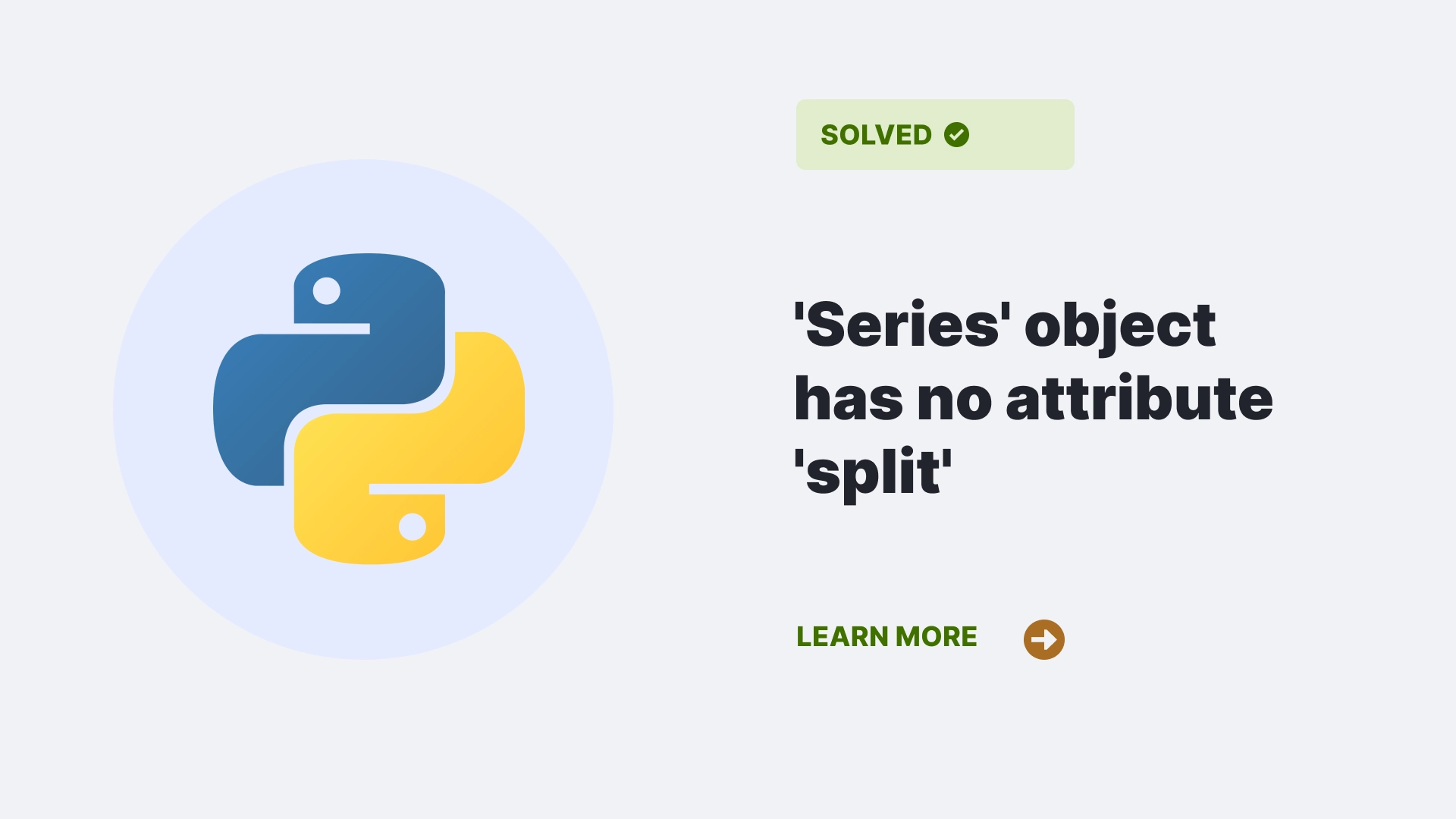If you are working with pandas Series objects in Python, you may encounter an error AttributeError: ‘Series’ object has no attribute ‘split’ while attempting to use the split() method on a Series. This method is meant for strings, not Series, and it will raise an exception if you apply it to a Series. This article will give you walkthrough about the error, what causes it, and how to fix it.
Contents
What is the “‘series’ object has no attribute ‘split'” error?
The split(), split a string into a list of substrings based on a specified separator method is a built-in function in Python. For example, if you have a string s = “Hello, world!”, you can use s.split(“,”) to get a list [“Hello”, “world!”].
However, if you try to use the split() method on a pandas Series object, you will get an error like this:
import pandas as pd
s = pd.Series(["Hello, world!", "Goodbye, world!"])
s.split(",")AttributeError: 'Series' object has no attribute 'split.'
The ‘Series’ object has no attribute ‘split’ error tells us that the Series object does not have a split() method, and we cannot use it as if it were a string.
What causes the “‘series’ object to have no attribute ‘split'” error?
The split() method does not work on a Series object because a Series is a collection of values, not a single value. A Series can contain strings, numbers, booleans, or other data types. Therefore, applying a string method to a Series as a whole does not make sense.
To illustrate this, let’s look at an example of a Series that contains different data types:
import pandas as pd
s = pd.Series(["Hello", 42, True, 3.14])
s0 Hello
1 42
2 True
3 3.14
dtype: objectIf we try to use the split() method on this Series, we will get the ‘Series’ object has no attribute ‘split’:
import pandas as pd
s = pd.Series(["Hello", 42, True, 3.14])
s.split()AttributeError: 'Series' object has no attribute 'split'This is because the split() method does not know how to handle the different data types in the Series. It only works on strings and cannot split numbers or booleans.
How do you resolve the “‘Series’ object has no attribute ‘split'” error?
Two possible ways exist to resolve the split() error on a Series object, depending on what you want to achieve.
Use the str accessor
You can use the str accessor if you want to apply the split() method to each string value in the Series. This special attribute allows you to access string methods on a Series. For example, if you have a Series of names, you can use the str accessor to split them by spaces:
import pandas as pd
names = pd.Series(["Alice Smith", "Bob Jones", "Charlie Brown"])
names.str.split()0 [Alice, Smith]
1 [Bob, Jones]
2 [Charlie, Brown]
dtype: objectThe result is a series of lists, where each list contains the substrings from the original string. You can also specify a separator other than space, such as a comma or a dash:
import pandas as pd
emails = pd.Series(["[email protected]", "[email protected]", "[email protected]"])
emails.str.split("@")0 [alice, gmail.com]
1 [bob, yahoo.com]
2 [charlie, outlook.com]
dtype: objectThe str accessor can also be chained with other string methods, such as lower(), upper(), replace(), etc. For example, if you want to convert the email addresses to lowercase and replace the dots with underscores, you can do this:
import pandas as pd
emails = pd.Series(["[email protected]", "[email protected]", "[email protected]"])
emails.str.lower().str.replace(".", "_")0 alice@gmail_com
1 bob@yahoo_com
2 charlie@outlook_com
dtype: objectConvert the Series to a string
If you want to treat the entire Series as a single string, you can convert it to a string to the to_string() method. For example, if you have a series of words, you can use the to_string() method to get a string representation of the Series:
import pandas as pd
words = pd.Series(["Hello", "world", "Python", "pandas"])
words.to_string()0 Hello
1 world
2 Python
3 pandasThe result is a string that contains the index and the values of the Series, separated by newlines. You can then use the split() method on this string to get a list of substrings:
import pandas as pd
words = pd.Series(["Hello", "world", "Python", "pandas"])
words.to_string().split()['0', 'Hello', '1', 'world', '2', 'Python', '3', 'pandas']FAQs
How can I split a Series by multiple separators?
You can use a regular expression as the separator argument in the str.split() method. For example, if you want to split a Series by commas, spaces, or dashes, you can use s.str.split(“[, -]”).
How can I split a Series into columns based on a separator?
You can use the expand argument in the str.split() method to return a DataFrame of columns rather than a series of lists. For example, if you want to split a series of names into first and last names, you can use s.str.split(” “, expand=True).
How can I split a Series and keep the separator in the result?
You can use the keep argument in the str.split() method to specify whether to keep the separator in the result. For example, if you want to split a series of sentences by periods and keep the periods, you can use s.str.split(“.”, keep= “right”).
Conclusion
In this article, we have learned what the ‘Series’ object has no attribute ‘split’ error on a Series object means, what causes it, and how to fix it. We have seen that the split() method is a string method that does not work on a Series object. We have also seen two possible ways to resolve the ‘Series’ object has no attribute ‘split’ error, depending on whether we want to apply the split() method to each string value in the Series or the entire Series as a single string. We have also learned some frequently asked questions and answers about this error. We hope this article has helped you understand and resolve the split() error on a Series object in Python.
References
Master day-to-day error handling by following PythonClear errors.

